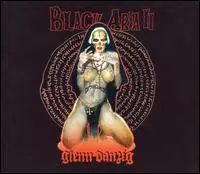Doubtlessly, Glenn Danzig's new album, Black Aria II, will be heavily criticized in many music periodicals. The sequel to 1993's Black Aria features a similar tone to its predecessor. However, this piece features less classical music exercises and more dirge-like compositions. Already, a few reviews of the album have panned these tracks for lacking real substance. This is a shame as these experiments may prove to be important in the Danzig timeline. Black Aria II features the father of horror punk experimenting with many new types of sounds and song structures which may indeed be the catalyst for the next great Danzig record.
As with Black Aria I, in place of the usual blues riffs and Elvis / Jim Morrison crooning, Black Aria II features cult-like chanting, operatic soprano vocals and timpani drums. Although the album has almost no lyrics, the music tells the story of Lilith, first wife of Adam. Most of the tracks strive to create more of an atmosphere rather than a complete song. Crescendos and decrescendos are on almost every track, as are thunderous drums and the sound of wind blowing.
While this makes for an interesting listen, it also does feel a little thin at some parts. Without actual singing or complex musicianship, some songs do tend to simply fade in and out, rather than engage the listener. But, it seems engaging standard musical tastes wasn't Danzig's goal here. Instead of creating a good "song," the album suggests Danzig wanted to create an interesting sonic experience. In place of a clever refrain, the album features an interesting sound. Instead of a snappy riff, a new style of multi-tracking is utilized. The music doesn't drive the listener, as with a classic Misfit track. Rather, it washes over the listener, submerging him or her in a mood rather than a rhythm.
It is easy to disregard these types of songs in favor of tighter tunes like "Mother," or "We Are 138." But, there may be more to Black Aria II than is apparent in the music itself. Remember that Danzig has founded his career on experimentation with new styles and sounds. Without experimenting with bass-driven songs, Danzig would never have created "Horror Business." Without his song structure experimentation in Samhain, Danzig would never have created "How the Gods Kill." Without his use of techno beats, Danzig would never have created "Deep." True, he has had some missteps along the way, but Danzig has also reaped many wondrous results from his experimentation. It is far better to have many great, different sounding albums with a few mediocre moments than having the same album recorded dozens of times.
As stated above, many reviews will likely pan Black Aria II. Those that don't will do something worse: ignore it. However, maybe this isn't so bad. Samhain received less publicity than the Misfits (and the Misfits didn't receive a heck of a lot of publicity back then), but it yielded some of Danzig's best work and also laid the foundation for four incredible albums. Even back in his Samhain days, Danzig was already flirting with Black Aria-type sounds in Unholy Passion's "Misery Tomb." Maybe, as he did with Samhain, Glenn Danzig will incorporate the best elements of his experimentation into his trademark sound and create his best album yet. A blues metal album with operatic elements helmed by Danzig certainly has potential. But, in the meantime, until this new fusion sees the light of day, we'll just have to chalk this up to valiant experimentation and play it at our next Halloween party.
